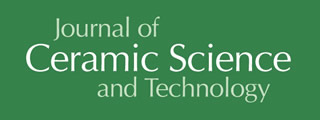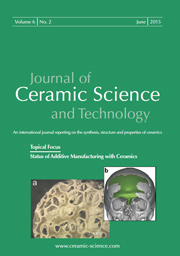Articles
All articles | Recent articles
Influence of Different Zn Substitution Sites on the Crystallinity and Morphology of Zn-Doped Nano-Hydroxyapatite Powder
Yangyang Wang, Tao Wang
College of Materials Science and Technology, Nanjing University of Aeronautics and Astronautics, Yudao Street 29, Nanjing 210016, China
received October 16, 2020, received in revised form February 17, 2021, accepted March 16, 2021
Vol. 12, No. 2, Pages 81-86 DOI: 10.4416/JCST2020-00023
Abstract
Zn-substituted hydroxyapatite (ZnHA) has been studied as a biomaterial with enhanced biological activity, which is related to its crystal structure and micromorphology. We investigated the inner contacts at the sites of Zn-substitution, crystal structure conversion behavior and variation of morphology in ZnHA. The composition of samples with different Zn/(Zn+Ca) molar ratios (0 mol%, 1 mol%, 5 mol%, 10 mol% and 20 mol%) was characterized by means of X-ray diffraction (XRD) and Fourier-transform infrared spectroscopy (FTIR). The morphologies of samples were examined with scanning electron microscopy (SEM) and high-resolution transmission electron microscopy (HRTEM). The Zn2+ ion distribution was analyzed by means of X-ray photoelectron spectroscopy (XPS). From the XRD and FTIR data, it could be observed that the crystallinity of the precipitates decreased with increasing content of Zn2+ ions, with the formation of amorphous phase when the concentration of Zn2+ ions exceeded 10 mol%. SEM and HRTEM results showed that the morphologies changed from nano-needle clusters to nanospheres with increasing concentration of Zn2+ ions. According to the XPS results, at low Zn concentrations (0 – 5 mol% Zn), the Zn2+ ions only occupied the Ca(II) sites. However, with the increase in the concentration of Zn2+ ions, Zn2+ ions also gradually occupied the Ca(I) sites. Hence, we can conclude that the change in morphology and crystal structure is affected by the Zn2+ ions occupying the different Ca2+ ions sites.
![]() Download Full Article (PDF)
Download Full Article (PDF)
Keywords
Zn-doped, hydroxyapatite, morphology, crystal structure, substituted sites
References
1 Fox, K., Tran, P.A., Tran, N.: Recent advances in research applications of nanophase hydroxyapatite, Chem. Phys. Chem., 13, 2495 – 2506, (2012).
2 Zhang, Y.G., Zhu, Y.J., Chen, F.: Novel interconnected nanochannel hydroxyapatite ceramics: synthesis, microstructure, and permeability, Ceram. Int., 43, 5403 – 5411, (2017).
3 Dorozhkin, S.V.: Calcium orthophosphates in nature, biology and medicine, Materials, 2, 399 – 498, (2009).
4 Bulut, B., Erkmen, Z.E., Kayali, E.S.: Biocompatibility of hydroxyapatite-alumina and hydroxyapatite-zirconia composites including commercial inert glass (CIG) as a ternary component, J. Ceram. Sci. Tech., 7, 263 – 276, (2016).
5 Greish, Y.E., Kenawy, S.H., Habib, S.I., Moussa, T.A., Shalaby, H.A., El Deftar, M.: Development of novel ZnO-doped hydroxyapatite polycarboxylate dental cement, J. Ceram. Sci. Tech., 2, 227 – 236, (2011).
6 Mehdi, R., Mohammadhossein, F., Omid, S., Lobat, T., Daryoosh, V.: Biodegradable magnesium bone implants coated with a novel bioceramic nanocomposite, Materials, 13, 1315 – 1330, (2020).
7 Lowry, N., Brolly, M., Han, Y., McKillop, S., Meenan, B.J., Boyd, A.R.: Synthesis and characterisation of nanophase hydroxyapatite co-substituted with strontium and zinc, Ceram. Int., 44, 7761 – 7770, (2018).
8 Kumar, G.S., Thamizhavel, A., Yokogawa Y., Narayana Kalkura, S., Girija, E.K.: Synthesis, characterization and in vitro studies of zinc and carbonate co-substituted nano-hydroxyapatite for biomedical applications, Mater. Chem. Phys., 134, 1127 – 1135, (2012).
9 Tank, K.P., Chudasama, K.S., Thaker, V.S., Mihi, J.J.: Pure and zinc doped nano-hydroxyapatite: synthesis, characterization, antimicrobial and hemolytic studies, J. Cryst. Growth, 401, 474 – 479, (2014).
10 Iyengar, G.V., Kollmer, W.E., Brown, H.J.M.: The elemental composition of human tissues and body Fluids: a compilation of values for adults., Int. J. Environ. Res., 58, 151 – 152 (1978).
11 Yuan, H.P., Fernandes, H., Habibovic, P., et al.: 'Smart' biomaterials and osteoinductivity, Nat. Rev. Rheumatol., 7, 1 – 1, (2011).
12 Webster, T.J., Ergun, C., Doremus, R.H., Rena, B.: Hydroxylapatite with substituted magnesium, zinc, cadmium, and yttrium. II. mechanisms of osteoblast adhesion, J. Biomed. Mater. Res. A, 59, 312 – 317, (2002).
13 Santos, M.H., Valerio, P., Goes, A.M., Leite, M.F., Heneine, L.G.D., Mansur, H.S.: Biocompatibility evaluation of hydroxyapatite/collagen nanocomposites doped with Zn2+, Biomed. Mater., 2, 135 – 141, (2007).
14 Bandyopadhyay, A., Bernard, S., Xue, W.C., Bose, S.: Calcium phosphate-based resorbable Ceramics: influence of MgO, ZnO, and SiO2 dopants, J. Am. Ceram. Soc., 89, 2675 – 2688, (2006).
15 Otsuka M., Ohshita Y., Marunaka S., Matsuda Y., Ito A., Ichinose N., Otsuka K., Higuchi W.I.: Effect of controlled zinc release on bone mineral density from injectable Zn-containing -tricalcium phosphate suspension in zinc-deficient diseased rats, J. Biomed. Mater. Res., 69A, 552 – 560, (2004).
16 Matsunaga, K., Inamori, H., Murata, H.: Theoretical trend of ion exchange ability with divalent cations in hydroxyapatite, Phys. Rev. B., 78, 094 – 101, (2008).
17 Byeon, I.S., Hwang, I.J., Choe, H.C., Brantley, W.A.: Electrochemically-coated hydroxyapatite films on nanotubular ti-nb alloys prepared in solutions containing ca, P, and zn ions, Thin Solid Films, 620, 132 – 138, (2016).
18 Montoya-Cisneros, K.L., Rendón-Ángeles, J.C., Matamoros-Veloza, Z., Yanagisawa, K.: Rapid synthesis and characterization of zn substituted hydroxyapatite nanoparticles via a microwave-assisted hydrothermal method, Mater, Lett., 195, 5 – 9, (2017).
19 Lyasnikova, A.V., Markelova, O.A., Lyasnikov, V.N., Dudareva, O.A.: Biocomposite plasma-sprayed coatings based on zinc-substituted hydroxyapatite: structure, properties, and prospects of application, Mech. Compos. Mater., 51, 1 – 4, (2016).
20 Koroleva, M.Y., Fadeeva, E.Y., Shkinev, V.M., Katasonova, O.N., Yurtov, E.V.: Hydroxyapatite nanoparticle prepared by controlled precipitation from aqueous phase, Russ. J. Inorg. Chem., 61, 674 – 680, (2016).
21 Kaygili, O., Keser, S.V.: Sol-gel synthesis and characterization of Sr/Mg, Mg/Zn and Sr/Zn co-doped hydroxyapatites, Mater. Lett., 141, 161 – 164, (2015).
22 Ren, F., Xin, R., Ge, X., Leng, Y.: Characterization and structural analysis of zinc-substituted hydroxyapatites, Acta Biomater., 5, 3141 – 3149, (2009).
23 Tang, Y., Chappell, H.F., Dove, M.T., Reeder, R.J., Lee, Y.J.: Zinc incorporation into hydroxylapatite, Biomaterials, 30, 2864 – 2872, (2009).
24 Kanazawa, T., Monma, H.: Amorphous calcium phosphate, Inorg. Mater., 1975, 187 – 191, (1975).
25 Blumenthal, N.C., Posner, A.S, Holmes, J.M.: Effect of preparation conditions on the properties and transformation of amorphous calcium phosphate, Mater. Res. Bull., 7, 1181 – 1189, (1972).
26 Kumar, G.S., Thamizhavel, A., Yokogawa, Y., Kalkura, S.N., Girija, E.K.: Synthesis, characterization and invitro, studies of zinc and carbonate co-substituted nano-hydroxyapatite for biomedical applications, Mater. Chem. Phys., 134, 1127 – 1135, (2012).
27 Moulder, J.F., Stickle, W.F., Sobol, P.E., Bomben, K.D.: Handbook of X-ray photoelectron spectroscopy. 1st ed. Perkin-Elmer Corporation, Minnesota, 1992.
28 Lala, S., Ghosh, M., Das, P.K., Das, D., Kar, T., Pradhan, S.K.: Structural and microstructural interpretations of Zn-doped biocompatible bone-like carbonated hydroxyapatite synthesized by mechanical alloying, J. Appl. Crystallogr., 48, 138 – 148, (2015).
29 Guo, D.G., Hao, Y.Z., Li, H.Y., Fang, C.Q., Sun, L.J., Zhu, H., Wang, J., Huang, X.F., Ni, P.F., Xu, K.W.: Influences of sr dose on the crystal structure parameters and sr distributions of Sr-incorporated hydroxyapatite, J. Biomed. Mater. Res. B, 101, 1275 – 1283, (2014).
Copyright
Göller Verlag GmbH


